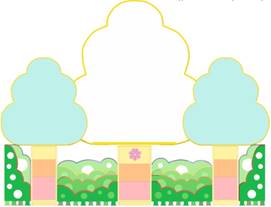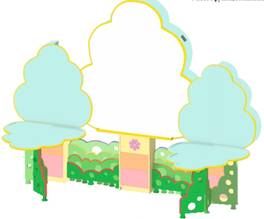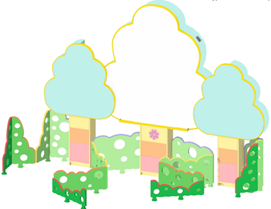Abstract
At present, there is a growing interest in foreign language teaching of preschoolers. Much has been done in the field of foreign preschool education but, undoubtedly, much remains to be done in it. The purpose of the present study is to develop the most effective approach in foreign language teaching of preschoolers. We have developed a new nature-activity approach, which is reasonable and practical. This approach considers the continuity of preschool and primary education through the developmental subject-based environment. We have outlined the main principles of the nature-activity approach: nature conformity, valeological and ecohumanitarien ones. The common-didactic and specific-methodical principles of foreign language teaching of preschool-aged children are based on the nature-activity approach. So, we need special conditions for realization of this approach. We turn our attention to a new and more urgent problem. The multi-purpose educational-gaming complex has been designed as an educational element for realization of the nature-activity approach in foreign language teaching of preschoolers.
Keywords: Nature-aligned teachingnature-activity approachmulti-purpose educational-gaming complex
Introduction
What is nature conformity in teaching a foreign language?
A person is an open system which develops in space, time and society. A humanitarian knowledge is an important component of the development of modern information society due to the awareness of human connection with nature. Modernization of the educational system in Russia is characterized by dramatic changes at every level. One of the major characteristics of modernization of the educational system in Russia is the development of the common educational environment aimed at the child`s personality development. The Federal State Educational Standards for preschool education set down the objectives of preschool education (Ordert, 2013). They are social age-based characteristics of possible achievements by children after completing preschool education that must be a prerequisite for further educational activity. The present and the future of each person, any nation and human depend on the relations in the system of “a person and nature”. The discipline of “Foreign language” has a complex, multi-purpose and multidisciplinary character, and as a humanitarian scientific discipline it concentrates around a person`s problems. Nature-conformable teaching is a multi-purpose basis of any learning and educational process (Biboletova et al., 2015). Natural conformity is one’s view on a person as a part of nature. An individual represents a whole organic “microcosm” with natural abilities and potential opportunities that are unveiled owing to the general world`s laws, the development of spiritual and value orientation, motivation of system holistic thinking and comprehension, love for work and creativity (Goncharenko et al., 2011).
Must creativity be a part of foreign language teaching of preschoolers?
In the Concept of Technological Education in the System of the General Education in the Russian Federation there is an accent on the fact that there is a gap between the education as “a conservative institute” and “life realities”. The technology as an educational subject reflects general principles of reformative activity of a person and all the aspects of material culture in its content. It is directed to the formation of object-transforming activity of pupils. It is necessary to create continuity of preschool and primary education not only in the context of the foreign language discipline content, but also technology discipline content, as it leads to the development of a person subject–based creative activity (The concept N 751, 2016). This is incentive for children to use the both hemispheres of the brain, e.g. the verbal and the non-verbal, the rational and non-rational ones. It is important that the language itself begins to actualize in case of any creative activity by children. The main aim of the both subjects (a foreign language and technology) is to prepare children for their participation in a rapidly changing world. They also provide opportunities for the application of knowledge and the ‘real world’ context for further learning. The modern information society is in need of a risk-taking creative person with holistic thinking and linguistic competence skills. Creativity is not an individual characteristic or an innate talent but is the application of knowledge and skills in new ways to achieve a valued goal. (Voronina et al., 2016) And as such, creativity is the ability that one can be taught and nurtured. A good teacher of humanities must understand that creativity needs to be a part of the learning-educational environment (Craft, 2005).
Problem Statement
It is possible to increase the effectiveness of foreign language teaching of preschool children due to nature-conformable teaching in a foreign language. Classroom management, materials and equipment must be designed in the content of the concept of the nature-activity approach. The multi-purpose educational-gaming complex may contribute a lot to the educational process and further learning activities of preschool children to engage and activate foreign language skills and creative activity.
Research Questions
What approach is the most productive in foreign language teaching of preschool children?
What common-didactic and specific-methodical principles of foreign language teaching can be outlined on the basis of psychophysiological, social-pedagogical, linguo-didactic, bioenergetics and spiritual-moral features of preschool children?
What pedagogical conditions, materials and equipment are necessary for realization of the nature-activity approach?
Purpose of the Study
The purpose of this research is to prove theoretically and develop the nature-activity approach in foreign language teaching of preschool children as well as to illustrate its realization on the basis of implementation of the multi-purpose educational-gaming complex.
Research Methods
There are following methods:
theoretical: analysis of scientific literature on the problem under study and normative documents; logical-historical analysis; experience synthesis of pedagogical activity of educational institutions; analysis, generalization and systematization of research work results; modelling method);
empirical: direct and indirect observation, scientific assessment, a questionnaire, testing, practice-search work);
methods of mathematical statistics.
Subjects (cases)
164 children participated during this research work. There were 114 preschool children aged from 3 to 6 years old and 50 primary school children aged from 7 to 9 years old.
Procedure
The experimental training was underway since 2014 till 2017 during 3 years on the basis of school №43 «School of Design» in the city of Perm, school №7 in Tobolsk city, children developing centres «Talento» in Perm and «EvroSad» in Tobolsk.
Findings
Methodology of the nature-activity approach in foreign language teaching is fundamental researches of the scientific-philosophical theories about genetic unity of the world (B.A. Astafyev), synergetic stage of science, the theory of biocentrism, concept of valueology, concept of noospheric education (N.G. Kulikova, Goncharenko), nature-conformable models of foreign language teaching (A.M. Kushnir, N.V. Maslova) and pedagogical researches in the field of foreign language teaching of preschoolers. We have studied cognitive, humanistic, learner-centred, communicative, whole-language, oral, product-oriented, process-oriented, comprehension, integrated approaches and preschool children`s features to conceptulize educational approach and its principles in foreign language teaching of preschoolers. The nature-activity approach reflects the principle of natural conformity, valeological and ecohumanitarien principles in a foreign language teaching.
The nature-activity approach means a formation of learning-educational process, leading to the development of holistic thinking and comprehension. The development of pupils’ identity bases on the nature-creative activity aimed at the transformation of the inner world and the outside material world as a whole self-organized open system (Bezzubtseva, 2010). It provides preschool and primary school continuity where training in a foreign language is not a purpose, but a learning style of the around world, and understanding themselves is as a part of the nature. The productive skills in a foreign language teaching are as a result of intrinsic motivation, situational language teaching, total physical response and creative activities.
We have analysed psychophysiological, social-pedagogical, linguo-didactic, bioenergetic features of the preschoolers (3-6 years old) and primary schoolers (7-8 years old). The most important preschool children features are an active growth, excess of energy, unexpected emotional explosions, irritability, originality, interest in newness, ingenuity, soul formation, holistic thinking and comprehension (a harmonious interaction of the right and left cerebral hemispheres), unavailability for a detailed studying of a subject (a holistic view of the world, without dividing it into sensual, logical, physical, intellectual and spiritual parts (Astafey, 2010), orientation to life through play and game. The preschoolers try to inspirit everyone and everything in the world, want to open their personality and big world around them. It`s a sensitive period of the development of language and listening skills (Gorlova, 2010).
On the basis of the principles of the nature-activity approach we are going to outline common-didactic and the specific-methodical principles of nature-conformable teaching in a foreign language of preschool children (Sergeeva & Kopylova, 2017). The common-didactic principles in a foreign language of preschool children are co-creation, technology, adaptation, animation and communication with nature. The specific-methodical principles in a foreign language of preschool children are nature-conformable originality, a genetically determined way of cognition, native language effect, value-communicative orientation and differential-integrated learning style (Kargina, 2011).
The main features of our approach are reflected in the nature-conformable factors in foreign language teaching of preschoolers. These are the following:
the design of a positive, rich emotional educational atmosphere for stimulation of creative activity;
the procedure of a real physical environment where physical events, processes are designed by the participants of communication process;
the integration of humanitarian and technical knowledge for the formation of the whole world image by means of creative activity;
a limited use of computer, TV and computer games;
the motivation for individual nature-conformable thinking of a person;
the application of nature-conformable course books for formation of the right mental image (Goncharenko et al., 2011);
kinaesthetic and visual perceptions that promote brain hemispheres synthesis;
a creative activity for stimulation of the right cerebral hemisphere;
the application of genetically determined way of cognition by means of foreign language teaching of preschool children. Classroom environment is very important for children. They need to see something imaginative in the classroom.
The application of these nature-conformable factors allows us to design the multi-purpose educational-gaming complex. We have designed the multi-purpose educational-gaming complex for realization of the nature-activity approach in foreign language teaching of preschoolers. This complex can organize developmental subject-based environment. It is a real physical environment that provides opportunities for the application of knowledge. We give the following definition of this educational-gaming environment. The educational-gaming environment is an action zone that helps a teacher organize the corresponding pedagogical conditions for a harmonious development of a person, develop system holistic thinking and comprehension, potential creative abilities of preschool children in foreign language teaching. Creativity needs to be a part of the teaching-learning environment. Games are known to be highly significant for the child`s personality development. It is a natural form of teaching preschool children. (Verkhoturova et al., 2016) This complex helps create conditions for the natural development of the children. We can offer a game that meets needs of the child and situation, involves the child in play interaction, transforms into fairy-tale characters, carries on a role dialogue, selects toy and necessary materials, and animates puppets. The multi-purpose educational-gaming environment will organize three action zones: 1. Demonstrative-educational space. 2. Emotional-figurative creation space. 3. Performing arts space (Kopylova, 2015).
The demonstrative-educational action zone (Fig.

Emotional-figurative creation space (Fig.

Performing arts space (Fig.

Conclusion
The experimental training took place in preschools. The training process involved 114 preschoolers: 57 children in the experimental group, and 57 children in the control group. Comparative analysis of the level of language skills development in preschool children from both the experimental and control groups was carried out. The dynamics of language skills development in preschool children from the control group was insignificant. We found significant positive dynamics in language skills development in preschool children from the experimental group. Owing to the multi-purpose educational-gaming complex, the level of language skills development increased in each group. On the average, it did in 70% of the children from the experimental group, and in the control group this rate increased only in 20% of the children. The preschool children in the experimental group showed higher level of language skills development. The usage of this complex in classroom management can helped children explore sounds, colour, texture, shape, form and space in two and three dimensions. They responded in a variety of ways to what they saw, heard, smelt, touched and felt. Through art, music, dance, stories and imaginative plays, they showed an increasing ability to use their language, speaking and listening skills in foreign language teaching.
This complex meets the requirements of the developmental subject-based environment of preschool aged children, motivates and creates a positive classroom climate and pedagogical conditions for the child's personality development, promotes the development of system holistic thinking, potential creative abilities and language skills development in foreign-language teaching. The nature-activity approach allows to prepare the preschool children for the future educational steps and does no harm to psycho-emotional and physical health of a child. Every one of us is born with creative power. Creativity is the core of our life.
Acknowledgments
Heartfelt thanks to all the pedagogical staff of the schools and children`s teaching centres, who participated in the diagnostic of preschool children and primary school children
References
- Astafev, B.A. (2010). Teoriya tvoreniya i geneticheskogo edinstva mira. Theory of Creation and Genetic Unity of the World)– M., 672 p. [in Russian]
- Bezzubtseva, N.A. (2010) Noosfernaya realnost v sotsioprirodnoy dinamike. Noosphere reality in the socio-natural dynamics.. Vestnik OGU; 55-59 pp. [in Russian]
- Biboletova, M.Z., Ladyizhenskaya, N.V. (2015) Vospitatelnyiy potentsial predmeta «Inostrannyiy yazyik» The educational potential of the subject "Foreign Language" 2-10pp. [in Russian]
- Craft, A. (2005). Creativity across the primary curriculum/Anna Craft. Рublished in the Taylor & Francis e-Library
- Goncharenko, M.S., Maslova, N.V., Kulikova, N.G. (2011). Noosfernoe obrazovanie – klyuch k zdorovyu. Noospheric education is the key to health). Institut holodinamiki, 124 p. [in Russian]
- Gorlova, N.A. (2010). Lichnostno-deyatelnostnyiy metod obucheniya inostrannyim yazyikam doshkolnikov, mladshih shkolnikov i podrostkov. Teoreticheskie osnovyi. Personal-activity method of teaching foreign languages of preschool children, junior schoolchildren and teenagers. Theoretical basis. MGPU, 248 p. [in Russian]
- Kargina, Z.A. (2011). Sovremennyie metodologicheskie podhodyi v sfere dopolnitelnogo obrazovaniya detey (Modern methodological approaches in the field of additional education for children) Vestnik, Tomsk, , 6-11pp. [in Russian]
- Kopylova, E.V. (2015). Multi-purpose educational-gaming complex. Patent RF №97239, 2015 [in Russian]
- Order of the Ministry of Education and Science of Russia (2013). Prikaz Minobrnauki Rossii ot 17.10.2013 N 1155 “Ob utverzhdenii federal’nogo gosudarstvennogo obrazovatel’nogo standarta doshkol’nogo obrazovaniya” (Zaregistrirovano v Minyuste Rossii 14.11.2013 N 30384) (Order of the Ministry of Education and Science of Russia from 17.10.2013 N 1155 "On the approval of the federal state educational standard of preschool education" (Registered in the Ministry of Justice of Russia in 14.11.2013 N 30384) [in Russian]
- Sergeeva, N.N., Kopylova, E.V (2017). Priroda-deyatel'nostnyj podhod v obuchenii inostrannomu yazyku detej doshkol'nogo vozrasta, YAzyk i kul'tura; Nature-activity approach in teaching foreign language to preschool children, Language and culture. Tomsk, 279-291pp. [in Russian]
- The concept of technological education in the system of general education in the Russian Federation (2016). Koncepciya tekhnologicheskogo obrazovaniya v sisteme obshchego obrazovaniya v Rossijskoj Federacii (utverzhdena rasporyazheniem Pravitel'stva Rossijskoj Federacii ot 27.06.2016 N 751) (The concept of technological education in the system of general education in the Russian Federation (approved by the decree of the Government of the Russian Federation from 27.06.2016 N 751) [in Russian]
- Verkhoturova, J.А., Galaguzova, J.N., Sergeeva, N.N. (2016). The technique of playing skills development of parents raising young children. Procedia: Social and behavioural Science 233, 150–154pp.
- Voronina, L.V., Utyumova, E.A., Sergeeva, N.N. (2016). Development of algorithm skills in preschool children. Procedia. Social and behavioural Science. 23, 155–159pp.
Copyright information

This work is licensed under a Creative Commons Attribution-NonCommercial-NoDerivatives 4.0 International License.
About this article
Publication Date
13 July 2018
Article Doi
eBook ISBN
978-1-80296-042-6
Publisher
Future Academy
Volume
43
Print ISBN (optional)
-
Edition Number
1st Edition
Pages
1-694
Subjects
Child psychology, developmental psychology, child care, child upbringing, family psychology
Cite this article as:
Sergeeva, N., & Kopylova, E. (2018). Methodology Of The Nature-Activity Approach In Foreign Language Teaching Of Preschoolers. In S. Sheridan, & N. Veraksa (Eds.), Early Childhood Care and Education, vol 43. European Proceedings of Social and Behavioural Sciences (pp. 680-687). Future Academy. https://doi.org/10.15405/epsbs.2018.07.90

